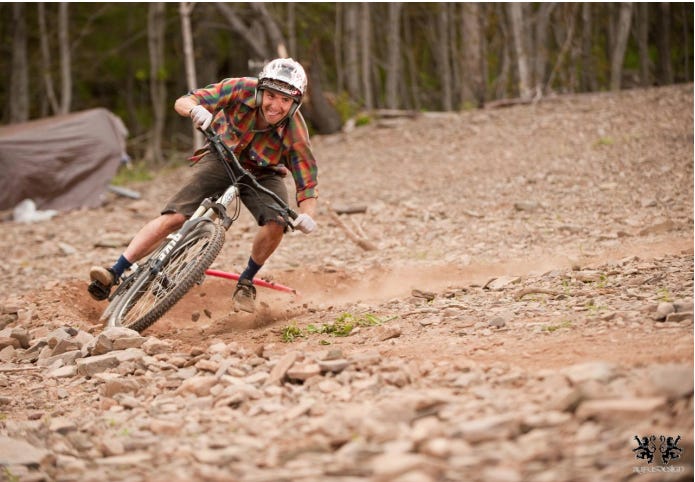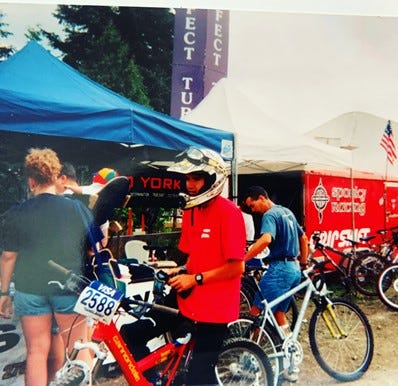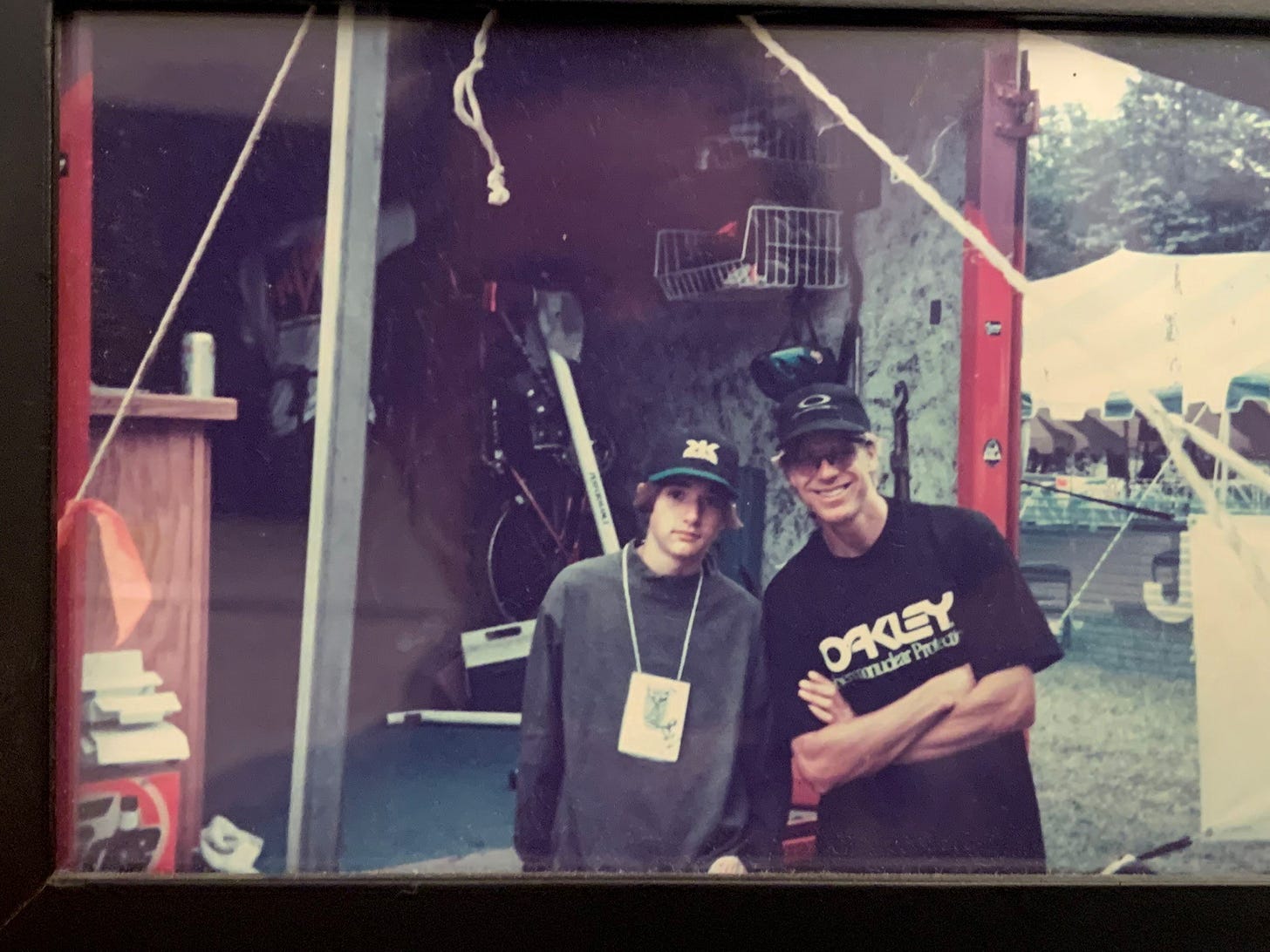
Out of True (OOT): What’s your history with bikes and riding them? Did you ride as a kid? When did you get into it? Was it a sudden or a slow thing? Why do you keep doing it?
Mickey Denoncourt (MD): Growing up in Southern Maine, my gang of adrenaline junky preteen friends used mountain bikes to find the tallest things we could jump off of into water all summer. Freedom, transportation, and a wee bit of conspicuous consumption (Mommmm, everyone else has a Cannondale!) drove those first rides. The world around me was billowing clouds of seafoam, tourists, abandoned ski areas and overgrown trolley roads. A proper Mainer, my parents met Apres Ski and got married in the Sugarloaf parking lot- I started DH skiing without parental supervision around the age of 3. Going very fast down ski slopes in the winter and running rec league track and field in the summer became my identity by the time I was in second grade. Go fast... With good form if you want to do it again, faster... Repeat.
Sixth grade saw our family move to a large barrier island off the South Carolina coast. What few friends I had at the time were suddenly 1200 miles away, heck, dry land with hills took a solid 2.5 hours to drive to. The kids at school, even the jocks, could barely run a mile. They hit round objects with clubs and sticks. There certainly wasn’t a Track and Field team, let alone a Cross Country running team. I was lost, and very, very, very angry about being uprooted and transplanted into a foreign environment that barely felt like it had the preexisting conditions to support human life as I had hitherto known it. One day, by chance, I wandered into a windsurfing store and saw a flier for a mountainbike race, ON the island. I had a mountainbike (that I had never actually ridden on singletrack trail before), I could run faster and longer than anyone in gym class, and I had been throwing myself down ski slopes for nearly 10 years at that point. Perhaps I had found a new sport?
At 9:15am on the morning of the first day of my 13th year- my first bike race started. By 9:30am I was stuck in my toeclips, face down in a puddle, the leather lace of my meaty hiking boot wrapped around my pedal spindle. After extricating myself, I probably passed a few people, when I wasn’t running into pinetrees or slicing my hands open on the palm fronds that lined the hyper-twisty trail system. The combination of speed, fitness, self reliance and resilience was golden to a kid raised on the motto Dirigo.
After a year in the wilderness I had found people to care about, who cared for me. Our nascent scene of tweens and young teens were in the right place at the right time. Our local races only lasted two years, but out of our scene emerged National Champions, World Cup racers, and senior executives for brands like Shimano and Chris King. All of us kids shared a deep desire to get off the island and race. Our parents, the local bike shop and even local tourist-oriented businesses made it possible for a scrappy pack of longhaired beach kids to travel 4.5+ hours each way, nearly every weekend to race around the Southeast. By the next year, with the sonic screech of the MTB boom deafening us to all realities, I found my intentional community- the MTB race circuit. The kids- the pros, the industry representatives, the promoters, and to a lesser extent the adult participants became my “real friends”. 15 was a turning point- the first year I raced more than one National race, my first year working with a professional coach, my first year racing the entire Florida State Championship series, my first(and sadly some of my last) photo contingency checks from sponsors and the beginning of cultivating a sponsorship relationship with a bike brand that became a belief system, that gave me unique viewpoint to witness the end of American bicycle manufacturing, Private-Equity funded leveraged buyouts, licensing and distribution deals gone afoul, and that ultimately introduced me to the world of rider-owned BMX brands.

OOT: You’ve worked in the bike world for some time. Tell us please about how you got into it, how it’s changed, and about some of the pleasures and challenges of it.
MD: My first bikeshop job came a week after my first race. I was 13, and I don’t think I was getting paid, except in the form of hazing. After getting hazed by adults got tiresome, I started bussing tables to help cover some of the costs of racing. At 16, I started spending summers in Connecticut and New York doing odd jobs for the bike brand that built my race bikes during the week and traveling with the team trailer to events on the weekend to race and sell t-shirts for gas money home.
I didn’t really start working in bike shops until college- first as the outdoor program equipment manager at my school, and eventually at the local bike shop in Western Massachusetts where a few other U23 members of the road and cyclocross racing program I was involved with worked.
I was lucky enough to have an amazing series of mentors at those first few bike shop jobs, and because of my already extensive racing experience(and having already been coached by two amazing coaches who allowed me to make teachable mistakes of my own), I started a cycling coaching business my 3rd semester in school. My undergraduate education is a bespoke bit of self-directed inquiry, steeped in exercise physiology, ergonomics and investigations into inquiry-based pedagogical models for teaching middle school science.
The majority of the work I did in the bike shop was race bike focused. As I aged out of the U23 ranks, I changed my focus from XC/CX/Road racing to the gravity mtb disciplines, just as one of the key members of the brand that sponsored me in highschool received funding to build a new Downhill and Freeride focused brand.
After graduating college, I split my time between an Ebike startup(in 2005!) that I was doing design and fabrication work for, running a racing program and doing product development for my bike sponsor, and running my own coaching/promotions/athlete management business for cycling. In my mid-20’s I had the ability to re-start the brand I raced and rode for in high school, and perhaps am most notorious for being one of the last people to market affordable American made aluminum frames for Road, CX and XC racing. The Vortex consumed me for nearly a decade, and led me down some interesting paths, like finding capital and staff to briefly re-open a tubing plant that Cannondale abandoned when they stopped manufacturing bikes in the USA to help keep the final scalable integrated American OE frame vendor in business after their accountants had forced them to sell off their draw benches for making butted tubing due to an overall, (not so)shocking collapse in American bicycle manufacturing.
Since then I have done a few months in bike shops, but have spent far more time doing production management and scheduling for friend’s machine shops, running races, doing brand and product consulting for cycling startups, and especially as of late, building pumptracks, trails and slalom tracks and promoting, timing, announcing and officiating at bike races. At 42, I’ve worked “outside of the bike industry” for cumulatively less than a year. That’s why I’m always broke!

OOT: What bike riding projects have you been involved with around Roanoke? Any projects cooking right now?
MD: I was instrumental in getting modern feature-rich bike-optimized trail going in Franklin County, and have done quite a bit of work building feature-rich bike optimized trail in Blacksburg. Pre-Pandemic(and pre collapse of Cyclocross) I also ran a few regional cyclocross races in Franklin County and promoted, announced and officiated the first ever VA state DH, Enduro and short track XC championships The last bike project I am likely to be involved with in this area is another phase of bike optimized feature rich trail in Blacksburg this spring.

OOT: If you were forced for a month to ride your bike full time through a different era in history, what era would it be, where would you be riding, and what month/season would it be?
MD: I would love to be at Vincent Vincete of America’s first Reseda to the Sea- the first real “MTB” race in SoCal, promoted by a psychedelically altered roadkill eating ex-Olympic road racer and a crucial cauldron where the BMX world met the road racing world, and the “industry” of mountain bike product development was born. From the top of Topanga Canyon to the sleepy village of Reseda, this mass-start point to point downhill race is where the garage innovators of BMX met the garage innovators in road bike racing frame building, and key staff from brands like Mongoose, Shimano and Tioga to truly give birth to the mountain bike industry. The best riders in BMX and Road racing went head to head far outside their comfort zones to create a new sport. Without VVA and those early SoCal races, the history of the MTB industry would be entirely different, and the people who influenced me so much as a kid and young adult, I likely would have never met.
Mountainbiking is still an incredibly young sport. We are lucky that those who were instrumental in pushing it out of the crib are still just a phone call away- far too often people try to re-invent bike racing, instead of analyzing the past and moving forward constructively, with respect and understanding of what has come before. Recent de-evolutinary trends, like “gravel racing” make me cringe, as they disrespect the hard work of our elders, who gave everything to make MTB racing it’s own unique and vibrant sport.

OOT: Who are a few folks in the bike industry whose work and/or energy excites you these days?
MD: Neko Mullaly, Sean Leader, Frank Wadelton, Dave and Terry Berger, Josh Ogle, Chris Bishop, Nic Crumpton.


OOT: What’s your go-to, after work ride? Weekend ride? One of your go-to snacks while riding?
MD: If I’m “working” it usually means I am in the woods building trails- so my favorite after work rides are test runs on that day’s freshly built trail. Within 4.5 hours of Roanoke, GNCC at Ride Kanuga is my happy place. Anywhere with good land management and professionally built and maintained MTB trail makes me happy though. We’ve come so far as a sport over the last 30 years! As for snacks, it’s hard to beat the energy density of those Justin’s almond butter packets!



